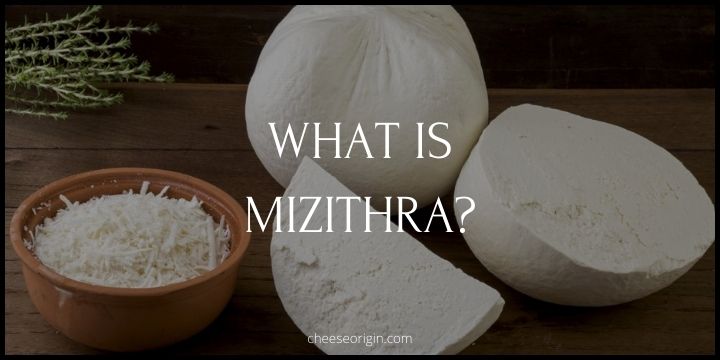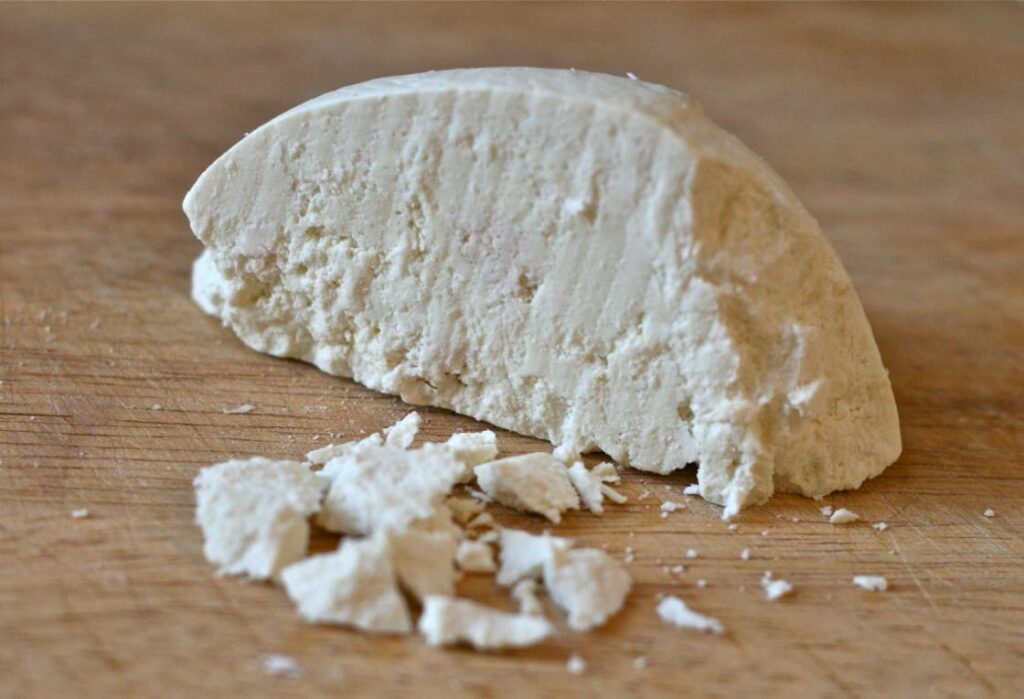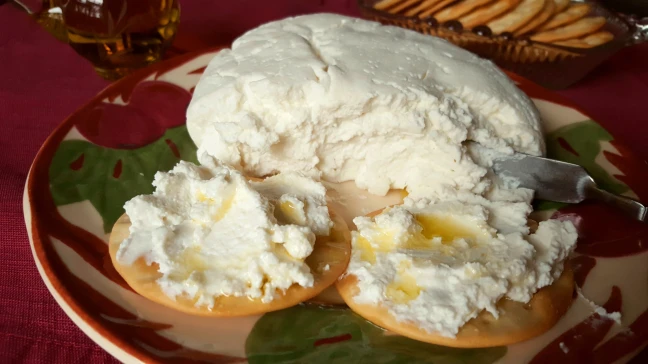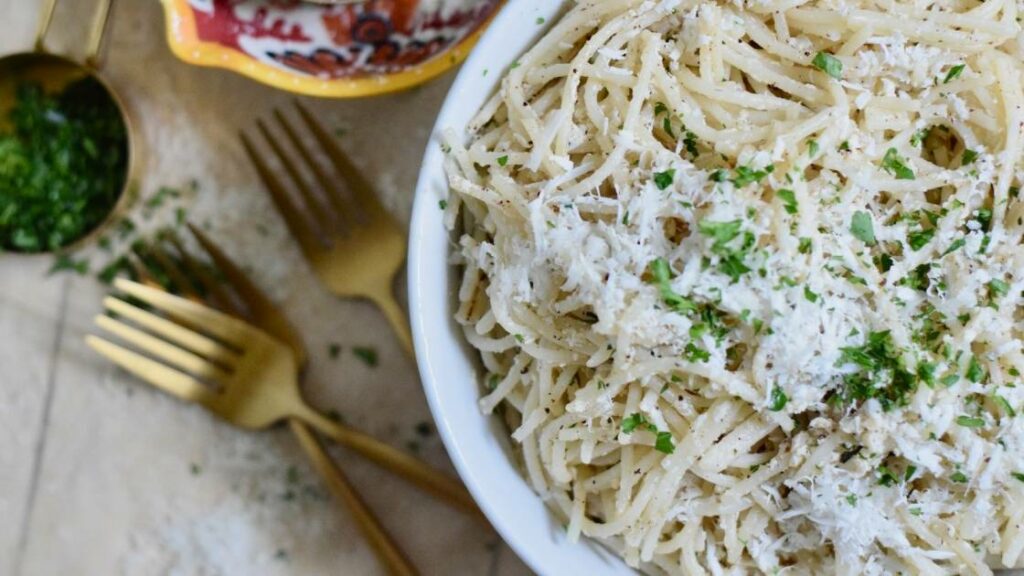What is Mizithra? Greece’s Gift to the Cheese World

Dive into the world of Mizithra, a Greek treasure that has graced the culinary scene for thousands of years. This versatile whey cheese, made from sheep or goat’s milk, or often a blend of both, is a staple in Greek cuisine. Whether fresh and creamy or dry and salty when aged, Mizithra’s distinctive taste profile offers a unique gastronomic journey.
Quick Facts About Mizithra
| Fact Category | Details |
|---|---|
| Origin | Greece |
| Made From | Sheep’s and sometimes goat’s milk |
| Cheese Type | Fresh or Aged |
| Taste | Creamy and mild (Fresh). Salty and sharp (Aged) |
| Texture | Soft and moist (Fresh). Hard and crumbly (Aged). |
| Color | White |
| Aging Time | 3 months (for the aged version) |
| Popular Uses | Grating over pasta, salad, baking |
| Shelf Life | 1-2 weeks (Fresh), several months (Aged) |
| Nutrition | High in protein and calcium |
| Availability | Year-round |
| Pairings | Red wine, fruits, crusty bread |
| Similar Cheeses | Ricotta, Feta |
| Famous Dishes | Spaghetti with Mizithra and Browned Butter |
| PDO Status | Protected Designation of Origin in Greece |
| Production Method | Traditional, artisanal |
| History | Ancient Greek origins, mentioned by Homer |
| Serving Temperature | Room temperature |
What is Mizithra?

Mizithra, a name that sings of sun-drenched Greek landscapes and rich culinary tradition, is a cheese that truly encapsulates the essence of Greece. Originating from ancient times, Mizithra is a testament to the timeless allure of simple, yet high-quality ingredients. Made predominantly from sheep’s milk, and sometimes a blend of sheep’s and goat’s milk, this cheese offers an authentic taste of the Mediterranean.
There are two types of Mizithra: fresh and aged. The fresh version is soft and moist, with a creamy, slightly sweet flavor that’s perfect for spreading on crusty bread or using in baking. On the other hand, the aged version, often referred to as “hard” Mizithra, is a different creature altogether. After maturing for at least three months, it develops a hard, crumbly texture and a salty, sharp flavor that stands out in any dish. Aged Mizithra is often used as a grating cheese, adding a burst of flavor to pasta dishes and salads.
Beyond its delectable taste and versatility, Mizithra also boasts a high nutritional value. It’s packed with protein and calcium, making it a healthy addition to your diet. Whether you’re a cheese connoisseur or a curious foodie, Mizithra is a delightful discovery that promises to enchant your palate with its unique Greek charm.
What Does Mizithra Taste Like?
Mizithra cheese has a multifaceted flavor profile that varies depending on its age. Young, fresh Mizithra tastes sweet and milky, akin to fresh ricotta or cream cheese. It’s a soft, white, fluffy cheese that’s often used in a variety of dishes.
As Mizithra ages, it undergoes a significant transformation. The texture becomes rock-hard and the taste turns noticeably salty. This aged version, known as Dried Mizithra, is frequently savored as a grating or cooking cheese, particularly over spaghetti.
Regardless of its age, Mizithra often carries a slight tanginess, which can vary depending on the time of year it is made. Some describe it as a mild cheese with a hint of saltiness, but not as salty as feta. This balance of flavors makes it a versatile ingredient in many recipes.
In its aged form, Mizithra develops a sharp flavor and a fine floral scent, making it delicious when grated over pasta or rice. Despite its hardness, it doesn’t melt like other cheeses, instead imparting a nutty, salty bite that pairs perfectly with various dishes.
In its sweeter form, Mizithra is sometimes enjoyed as a dessert cheese, especially when paired with classic dessert ingredients. Whether you’re savoring it fresh or aged, Mizithra offers a unique taste experience that’s distinctly Greek.
Mizithra Tasting Notes
Fresh Mizithra Tasting Notes:
- Texture: Soft, moist, and creamy akin to fresh ricotta or cream cheese.
- Color: Bright white, indicating its freshness.
- Taste: Mildly sweet and milky with a subtle tanginess.
- Aroma: Lightly fragrant with fresh dairy notes.
- Pairings: Fruits, honey, or used as a spread on crusty bread.
- Use in dishes: Perfect for baking or as a topping for fresh salads.
Aged Mizithra Tasting Notes:
- Texture: Hard and crumbly, suitable for grating.
- Color: Off-white to pale yellow, indicating its aging process.
- Taste: Salty and sharp with a nutty undertone.
- Aroma: More pronounced than fresh Mizithra, with a distinct savory scent.
- Pairings: Ideal with red wine, olives, and hearty bread.
- Use in dishes: Often grated over pasta, risotto, or used in hearty baked dishes.
How to Eat Mizithra?

Fresh Mizithra:
- Spread it: Fresh Mizithra has a creamy texture that makes it ideal for spreading on warm, crusty bread or toast.
- Dessert Cheese: Pair it with honey, nuts, or fresh fruits for a light and refreshing dessert.
- Baking: It can be used in various baked goods, like Greek pies or cheesy bread, thanks to its mild flavor and soft texture.
- Salad Topping: Crumble it over salads for a creamy, tangy addition.
Aged Mizithra:
- Grate it: Aged Mizithra is hard and crumbly, which makes it perfect for grating over dishes like pasta, risotto, or salads.
- Cooking: Use it in cooking dishes that require a strong, salty cheese. It’s great in casseroles, lasagna, or stuffed peppers.
- Cheese Board: Include it on a cheese board with olives, cured meats, and hearty bread. Its distinct flavor pairs well with red wine.
- Garnish: Finely grate it as a garnish over soups or stews for an added burst of flavor.
Reminder: whether you’re eating fresh or aged Mizithra, it’s best served at room temperature to fully appreciate its unique taste and texture.
Where to Buy Mizithra?
10 Best Mizithra Substitutes
| Substitute | Description | Tasting Profile | Country of Origin |
|---|---|---|---|
| Feta Cheese | A crumbly, aged cheese traditionally made from sheep or goat’s milk. | Salty, tangy, slightly sour. | Greece |
| Ricotta Salata | A variation of ricotta cheese that is pressed, salted, and aged for at least 90 days. | A cow’s milk cheese can assume different textures according to its aging. | Italy |
| Pecorino Romano | A hard, salty cheese, often used for grating, made out of sheep’s milk. | Salty, sharp, pungent. | Italy |
| Parmesan | Known as Parmigiano Reggiano, it is a hard, dry cheese made from skimmed or partially skimmed cow’s milk. | Nutty, fruity, savory. | Italy |
| Asiago | A cow’s milk cheese that can assume different textures according to its aging. | Sweet, nutty, slightly tangy. | Italy |
| Manchego | A cheese made in the La Mancha region from the milk of sheep of the Manchega breed. | Nutty, caramel-like, slightly salty. | Spain |
| Grana Padano | A cheese similar to Parmesan, made from unpasteurized, semi-skimmed cow’s milk. | Sweet, nutty, full-flavored. | Italy |
| Kefalotyri | A hard, salty yellow cheese made from sheep milk and/or goat’s milk in Greece and Cyprus. | Sharp, salty, pungent. | Greece |
| Caciocavallo | A type of stretched-curd cheese made out of sheep’s or cow’s milk. | Spicy, salty, slightly smoky. | Italy |
| Gruyère | A hard yellow cheese, named after the town of Gruyères in Switzerland. | Sweet, slightly salty, creamy. | Switzerland |
What Pairs Well With Mizithra?

Food that goes well with Mizithra:
| Category | Food |
|---|---|
| Pasta | Spaghetti, Fettuccine, Penne |
| Bread | Ciabatta, Focaccia, Sourdough |
| Meat | Grilled Chicken, Lamb Chops, Beef Steak |
| Vegetables | Tomatoes, Spinach, Bell Peppers |
| Fruits | Figs, Pears, Apples |
| Nuts | Walnuts, Almonds, Pine Nuts |
| Herbs & Spices | Basil, Oregano, Black Pepper |
| Seafood | Shrimp, Calamari, Clams |
| Grains | Quinoa, Couscous, Bulgur |
| Condiments | Olive Oil, Balsamic Vinegar, Honey |
Also read: What Fruit Goes on a Charcuterie Board?
Beverage that goes well with Mizithra:
| Category | Beverage |
|---|---|
| Wine | Sauvignon Blanc, Chardonnay, Pinot Noir |
| Beer | Belgian Ale, Wheat Beer, Pilsner |
| Non-Alcoholic | Apple Cider, Lemonade, Iced Tea |
| Spirits | Ouzo, Metaxa, Brandy |
| Coffee | Espresso, Cappuccino, Greek Coffee |
| Tea | Chamomile Tea, Mint Tea, Earl Grey |
| Cocktails | Martini, Margarita, Mojito |
| Liquor | Sambuca, Limoncello, Amaretto |
| Digestifs | Grappa, Anisette, Fernet |
| Aperitifs | Campari, Aperol, Vermouth |
Also read: Top 10 Champagne & Cheese Pairings to Try at Least Once
Frequently Asked Questions
1. Is Mizithra cheese salty?
Mizithra cheese varies in taste depending on its age. Fresh Mizithra is soft, creamy, and has a sweet, milky taste due to the absence of salt. However, as it ages, it becomes harder, crumbly, and adopts a salty flavor. This aged version, often referred to as Dried Mizithra or Myzithra xeri, is typically used as a grating cheese over dishes like spaghetti. Despite its saltiness, it’s not as salty as feta but does have a light, nutty undertone.
2. What are other names for Mizithra cheese?
Mizithra cheese is also known as Myzithra, Mizythra, or Myzythra.
Also read:
- What is Goat Brie? A Unique Twist on a Classic Cheese
- What is Cambozola? Germany’s Unique Hybrid Cheese
- What is Crema Mexicana? The Creamy Crown of Mexican Cuisine
- What is Red Leicester? The Ruby of English Cheeses
- What is Wensleydale? From Monks to Modern Creameries
- What is Truffle Cheese? Savoring the Richness
- What is Babybel? A Snack-Sized Cheese Journey





